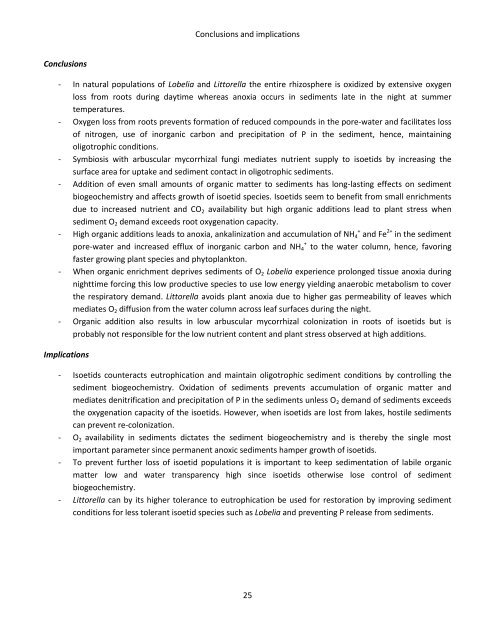Oxygen dynamics and plant-sediment interactions in isoetid ...
Oxygen dynamics and plant-sediment interactions in isoetid ...
Oxygen dynamics and plant-sediment interactions in isoetid ...
Create successful ePaper yourself
Turn your PDF publications into a flip-book with our unique Google optimized e-Paper software.
Conclusions <strong>and</strong> implicationsConclusions- In natural populations of Lobelia <strong>and</strong> Littorella the entire rhizosphere is oxidized by extensive oxygenloss from roots dur<strong>in</strong>g daytime whereas anoxia occurs <strong>in</strong> <strong>sediment</strong>s late <strong>in</strong> the night at summertemperatures.- <strong>Oxygen</strong> loss from roots prevents formation of reduced compounds <strong>in</strong> the pore-water <strong>and</strong> facilitates lossof nitrogen, use of <strong>in</strong>organic carbon <strong>and</strong> precipitation of P <strong>in</strong> the <strong>sediment</strong>, hence, ma<strong>in</strong>ta<strong>in</strong><strong>in</strong>goligotrophic conditions.- Symbiosis with arbuscular mycorrhizal fungi mediates nutrient supply to <strong>isoetid</strong>s by <strong>in</strong>creas<strong>in</strong>g thesurface area for uptake <strong>and</strong> <strong>sediment</strong> contact <strong>in</strong> oligotrophic <strong>sediment</strong>s.- Addition of even small amounts of organic matter to <strong>sediment</strong>s has long-last<strong>in</strong>g effects on <strong>sediment</strong>biogeochemistry <strong>and</strong> affects growth of <strong>isoetid</strong> species. Isoetids seem to benefit from small enrichmentsdue to <strong>in</strong>creased nutrient <strong>and</strong> CO 2 availability but high organic additions lead to <strong>plant</strong> stress when<strong>sediment</strong> O 2 dem<strong>and</strong> exceeds root oxygenation capacity.- High organic additions leads to anoxia, ankal<strong>in</strong>ization <strong>and</strong> accumulation of NH 4 + <strong>and</strong> Fe 2+ <strong>in</strong> the <strong>sediment</strong>pore-water <strong>and</strong> <strong>in</strong>creased efflux of <strong>in</strong>organic carbon <strong>and</strong> NH 4 + to the water column, hence, favor<strong>in</strong>gfaster grow<strong>in</strong>g <strong>plant</strong> species <strong>and</strong> phytoplankton.- When organic enrichment deprives <strong>sediment</strong>s of O 2 Lobelia experience prolonged tissue anoxia dur<strong>in</strong>gnighttime forc<strong>in</strong>g this low productive species to use low energy yield<strong>in</strong>g anaerobic metabolism to coverthe respiratory dem<strong>and</strong>. Littorella avoids <strong>plant</strong> anoxia due to higher gas permeability of leaves whichmediates O 2 diffusion from the water column across leaf surfaces dur<strong>in</strong>g the night.- Organic addition also results <strong>in</strong> low arbuscular mycorrhizal colonization <strong>in</strong> roots of <strong>isoetid</strong>s but isprobably not responsible for the low nutrient content <strong>and</strong> <strong>plant</strong> stress observed at high additions.Implications- Isoetids counteracts eutrophication <strong>and</strong> ma<strong>in</strong>ta<strong>in</strong> oligotrophic <strong>sediment</strong> conditions by controll<strong>in</strong>g the<strong>sediment</strong> biogeochemistry. Oxidation of <strong>sediment</strong>s prevents accumulation of organic matter <strong>and</strong>mediates denitrification <strong>and</strong> precipitation of P <strong>in</strong> the <strong>sediment</strong>s unless O 2 dem<strong>and</strong> of <strong>sediment</strong>s exceedsthe oxygenation capacity of the <strong>isoetid</strong>s. However, when <strong>isoetid</strong>s are lost from lakes, hostile <strong>sediment</strong>scan prevent re-colonization.- O 2 availability <strong>in</strong> <strong>sediment</strong>s dictates the <strong>sediment</strong> biogeochemistry <strong>and</strong> is thereby the s<strong>in</strong>gle mostimportant parameter s<strong>in</strong>ce permanent anoxic <strong>sediment</strong>s hamper growth of <strong>isoetid</strong>s.- To prevent further loss of <strong>isoetid</strong> populations it is important to keep <strong>sediment</strong>ation of labile organicmatter low <strong>and</strong> water transparency high s<strong>in</strong>ce <strong>isoetid</strong>s otherwise lose control of <strong>sediment</strong>biogeochemistry.- Littorella can by its higher tolerance to eutrophication be used for restoration by improv<strong>in</strong>g <strong>sediment</strong>conditions for less tolerant <strong>isoetid</strong> species such as Lobelia <strong>and</strong> prevent<strong>in</strong>g P release from <strong>sediment</strong>s.25
















